-
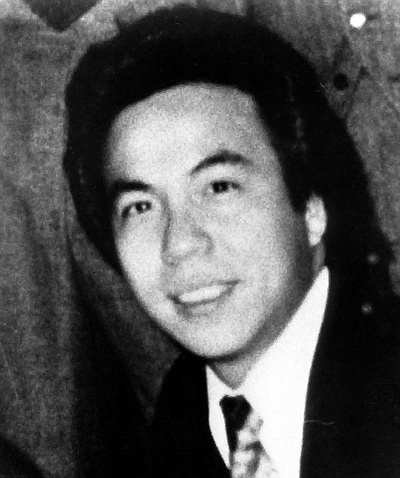 Who Killed Vincent Chin: Civil Rights Activism
Who Killed Vincent Chin: Civil Rights Activism USHG 8.3.4 Civil Rights Expanded – evaluate the major accomplishments and setbacks in securing civil rights and liberties for all Americans over the 20th century.
-
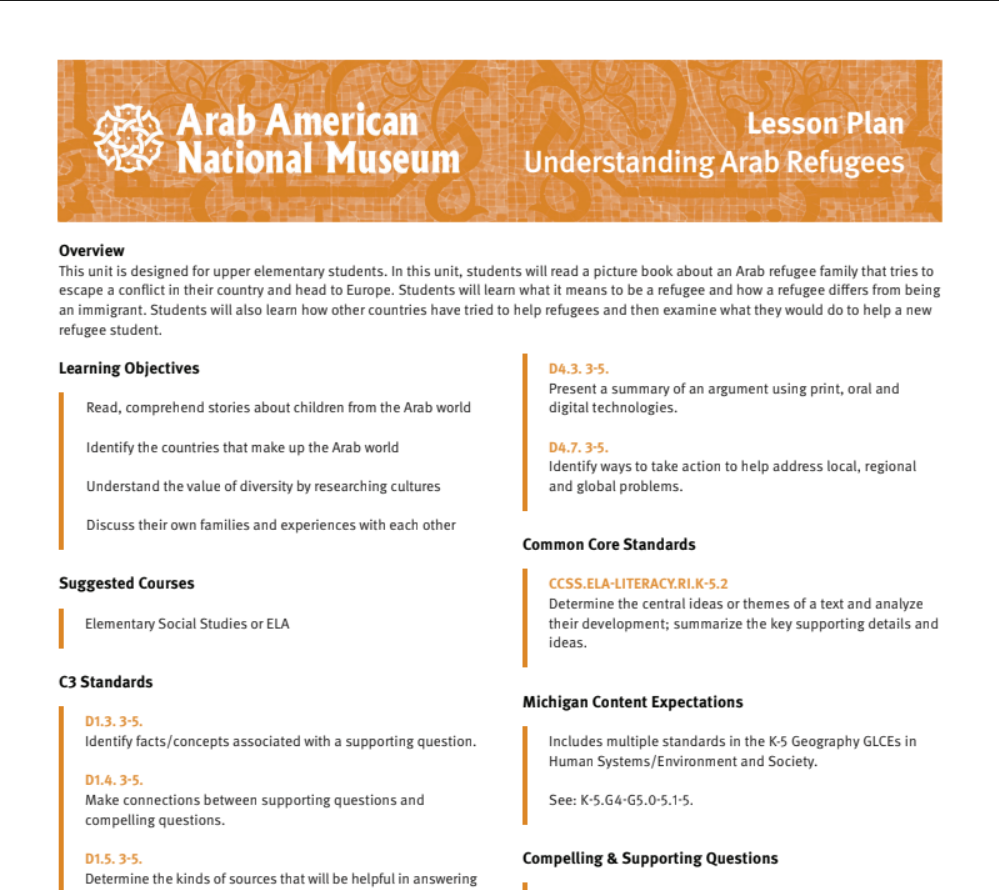 Understanding Arab Refugees Unit Plan
Understanding Arab Refugees Unit Plan
-
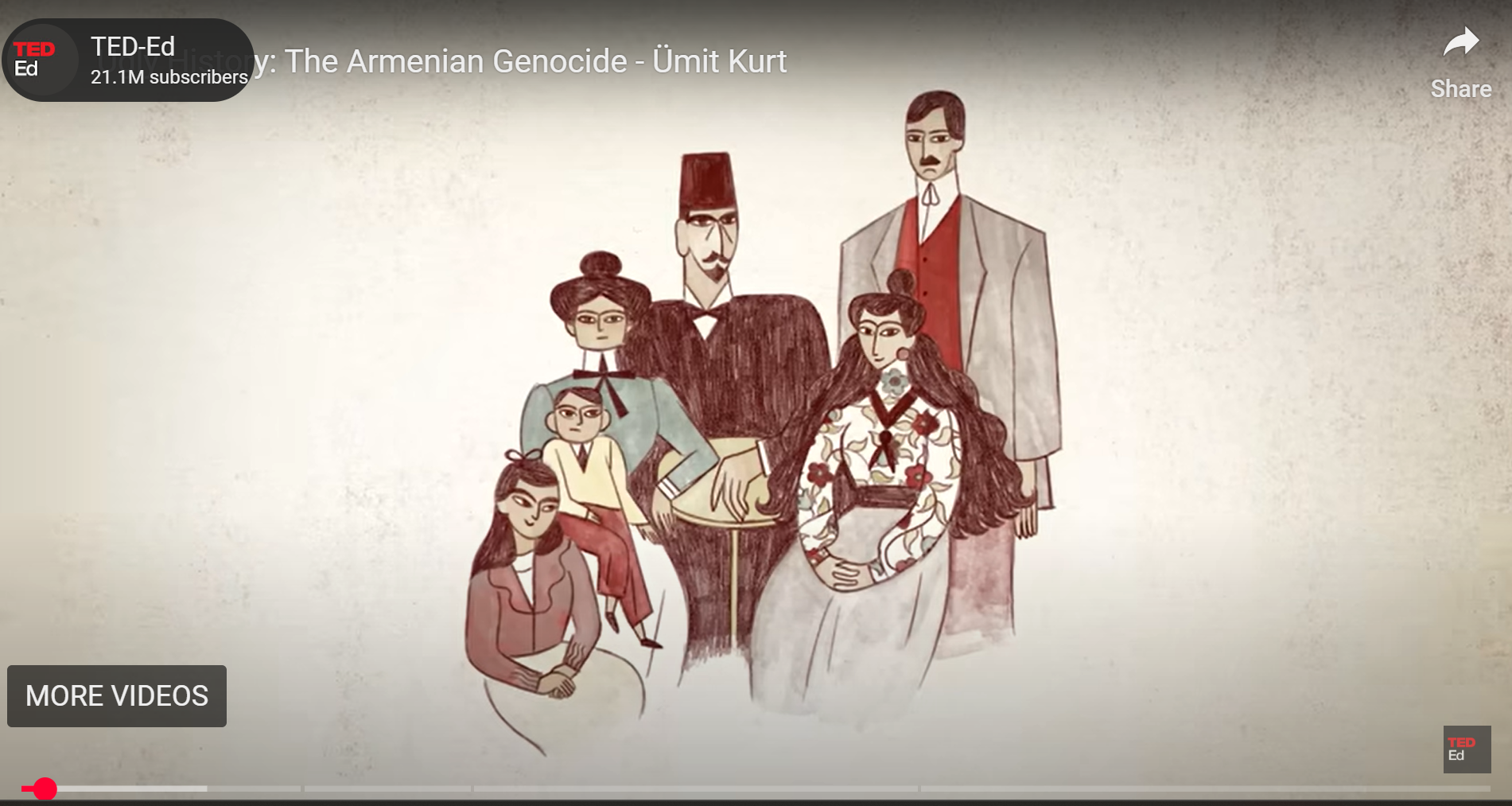 Ugly History: The Armenian Genocide
Ugly History: The Armenian Genocide WHG 7.2.1 World War I – explain the causes, characteristics, and long-term consequences of World War I, including the major decisions of the Versailles Treaty.
-
 This Land is Our Land Inquiry Unit: "How did (does) Europeans’ view of land impact their (our) relationship and interactions with Indigenous peoples?"
This Land is Our Land Inquiry Unit: "How did (does) Europeans’ view of land impact their (our) relationship and interactions with Indigenous peoples?" SOCIAL STUDIES:
3 – H3.0.5 Use informational text and visual data to compare how Indigenous Peoples and non-Indigenous Peoples in the early history of Michigan interacted with, adapted to, used, and/or modified their environments.
-
 The LGBTQ+ Identity: Teacher's Guide
The LGBTQ+ Identity: Teacher's Guide From the website:
"Understanding LGBTQ+ Identity: A Toolkit for Educators offers a series of digital media resources to help teachers, administrators, guidance counselors, and other educators understand and effectively address the complex and difficult issues faced by LGBTQ students.
"These resources, intended for use in teacher professional development settings or with GSAs, feature short segments of video content from the groundbreaking PBS Digital Studios show First Person. First Person delivers candid personal narratives illustrating larger conversations about gender, sexuality, social norms, and identity development.
"All video content is scaffolded by a suite of materials (informational text, conversation guides, discussion questions, and teaching tips) to facilitate their use in either classroom or professional development settings. The videos and accompanying educational resources are designed to help promote understanding, awareness, and self-esteem."
-
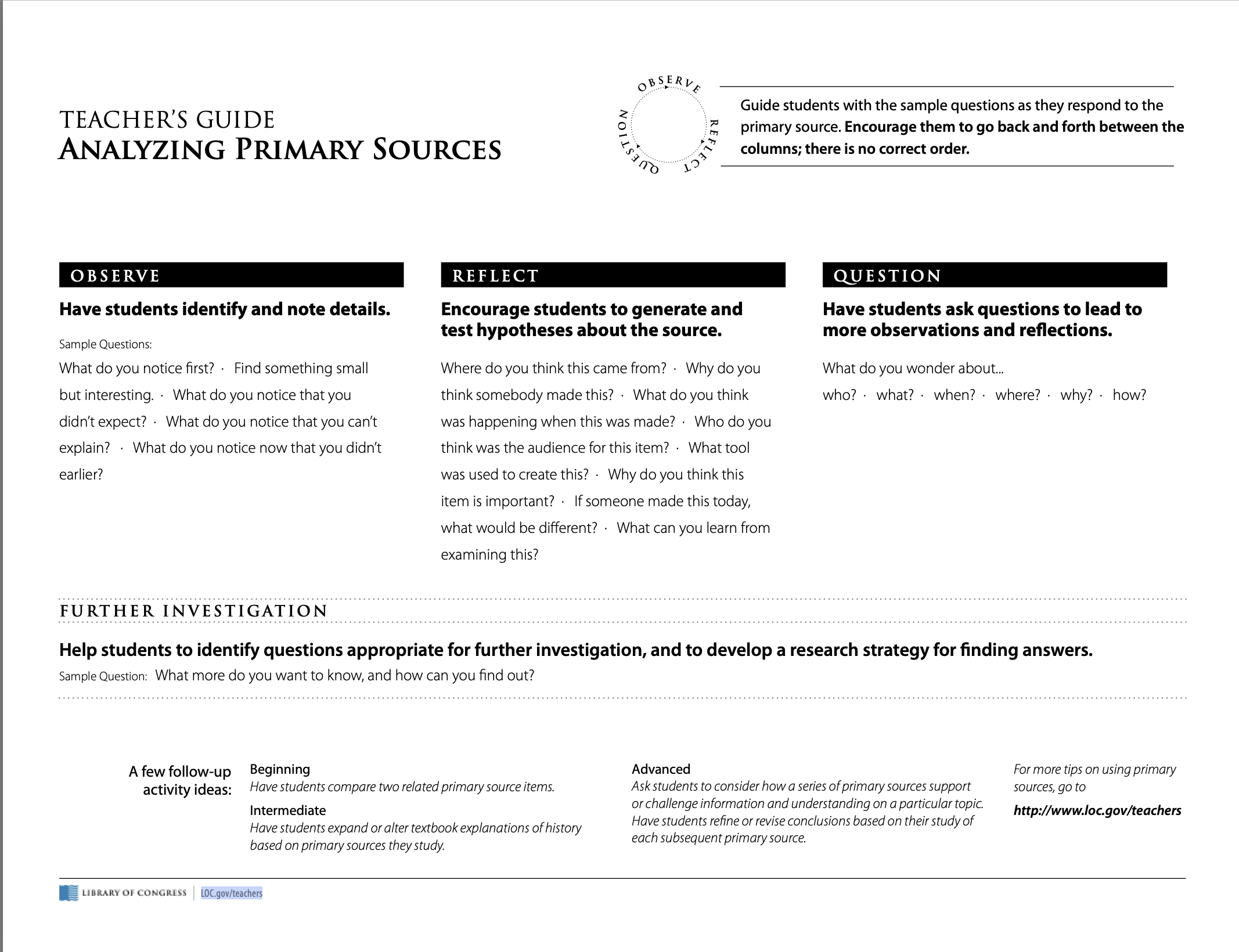 Teacher’s Guide: Analyzing Primary Sources
Teacher’s Guide: Analyzing Primary Sources A one-page guide for teachers on how to support students learning from and about primary sources.
-
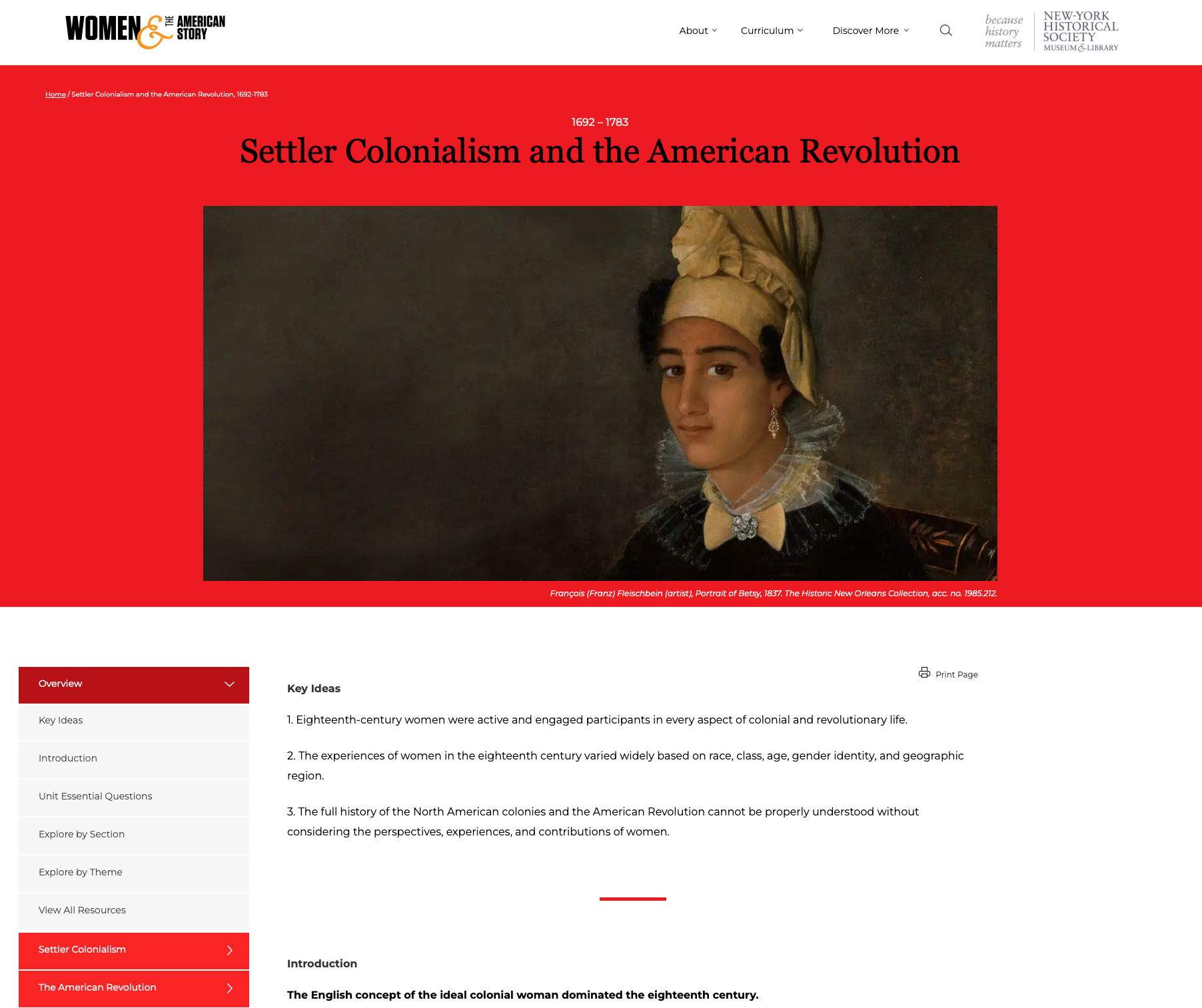 Settler Colonialism and the American Revolution: Women and the American Story History Unit (1692-1783)
Settler Colonialism and the American Revolution: Women and the American Story History Unit (1692-1783) Content wise, this unit goes best with 3rd grade history and 5th grade USHG Eras 2 and 3. There are opportunities for geography, economics, and civics integration. Which standards are best will depend on the resources you include, how you include them, and the grade you teach. That said, we do recommend these resources for all grades to help develop historical thinking and inquiry skills described in the K - 12 standards.
-
 Research and Resources on American Muslims and the Impact in the United States of Events in Gaza, Israel, and Surrounding Region
Research and Resources on American Muslims and the Impact in the United States of Events in Gaza, Israel, and Surrounding Region
-
 Muslim students face tough challenges during Ramadan. Here's what teachers can do to help.
Muslim students face tough challenges during Ramadan. Here's what teachers can do to help.
-
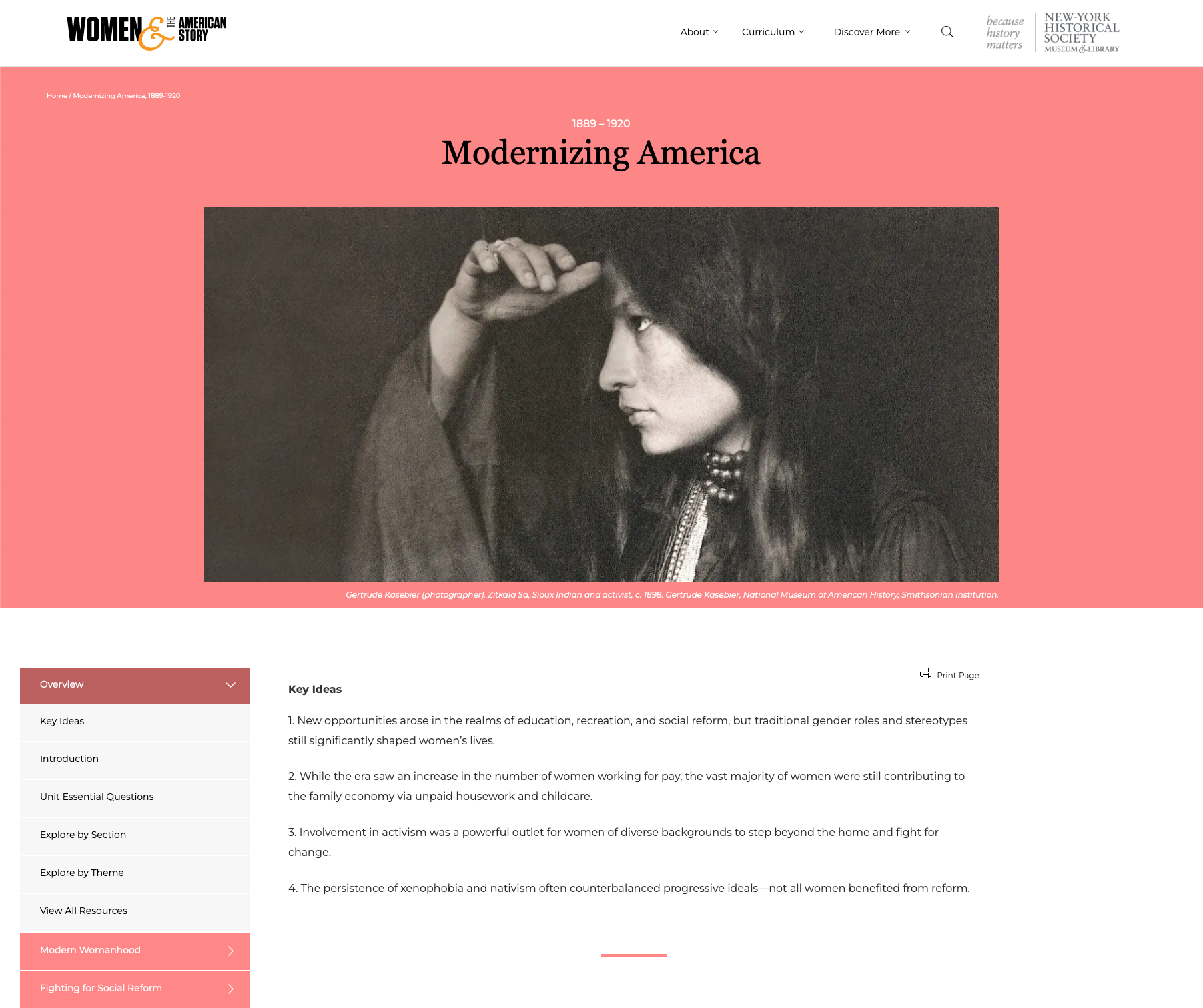 Modernizing America: Women and the American Story History Unit (1889–1920)
Modernizing America: Women and the American Story History Unit (1889–1920) Content wise, this unit goes best with 8th grade and High School USHG Era 6. There are opportunities for geography, economics, and civics integration. Which standards are best will depend on the resources you include, how you include them, and the grade you teach. That said, we do recommend these resources for all grades to help develop historical thinking and inquiry skills described in the K - 12 standards.
-
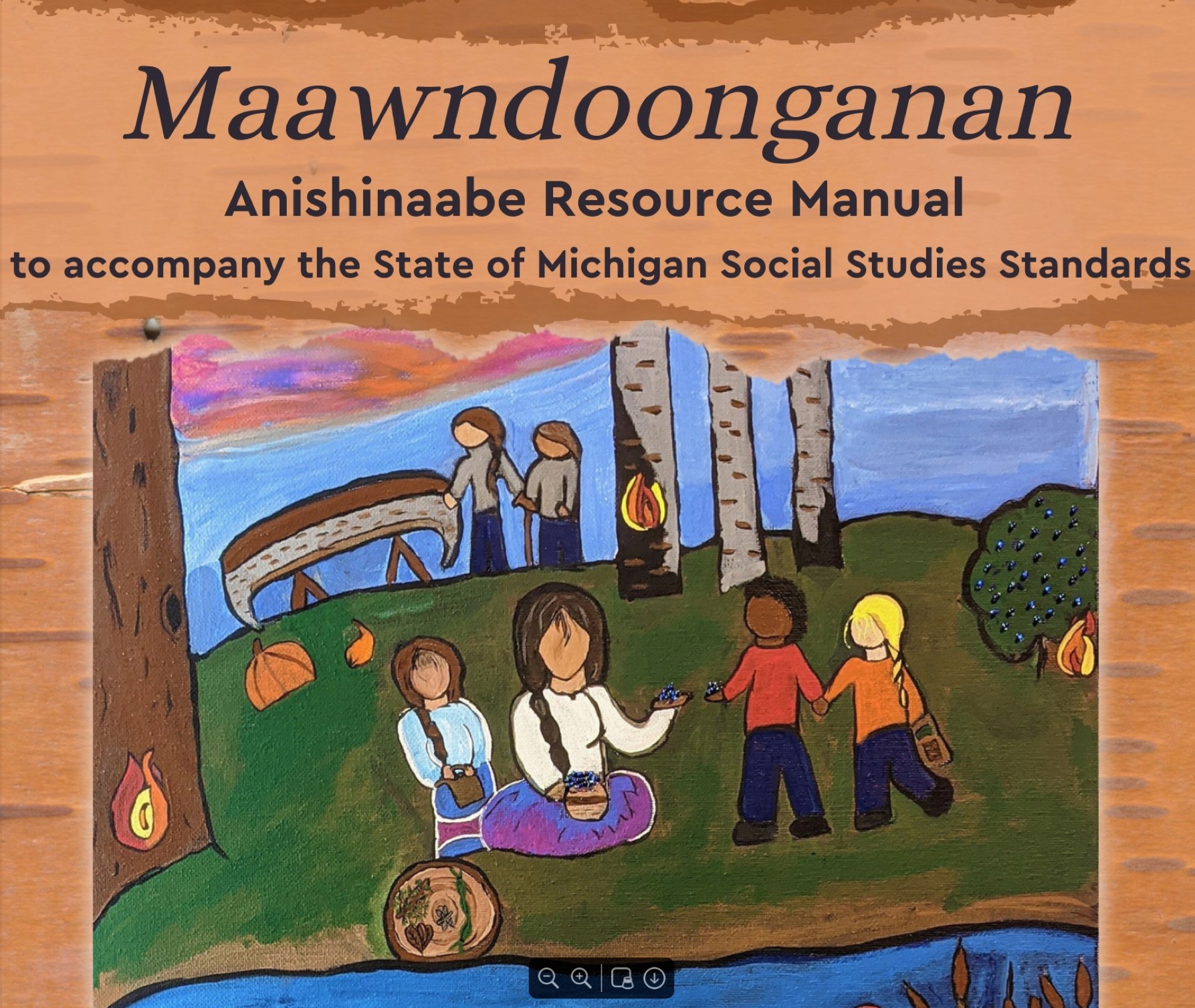 Maawndoonganan: Anishinaabe Resource Manual to Accompany the State of Michigan Social Studies Standards
Maawndoonganan: Anishinaabe Resource Manual to Accompany the State of Michigan Social Studies Standards K-12 applicable. Content expectation alignment is found within the document.
-
 Let’s Talk about Race: It isn’t Real, but Racism is Lesson Plan and Materials
Let’s Talk about Race: It isn’t Real, but Racism is Lesson Plan and Materials "Objective: Students will begin the process of “unlearning” the deeply ingrained societal myth that race is a biological reality by tracing the origins of the invention of ‘race.'
"THIS KEY CONCEPT IN AN ANTIRACIST CLASSROOM: “Racism is real, Race is not...so race does not account for racism.” - Dr. Barbara Fields
"If race isn’t real, where does racism come from? This lesson follows the research of Dr. Barbara Fields and Dr. Ibram X. Kendi to show to students that racism does not actually come from ignorance or hate, but from racist policies which were created for the financial benefit of people in power. Later, racism was invented to justify those racist policies. Unfortunately, the made-up idea of race is going to have a gigantic impact on the story of American history. "
-
 Lawmakers or Lawbreakers? The Crosswhites and Community of Marshall, Michigan
Lawmakers or Lawbreakers? The Crosswhites and Community of Marshall, Michigan 4 – H3.0.3 Use case studies or stories to describe the ideas and actions of individuals involved in the Underground Railroad in Michigan and in the Great Lakes region.
-
Jewish Life in Colonial America
5 – U2.1.3 Describe significant developments in the Middle colonies, including immigration patterns leading to ethnic diversity in the Middle colonies.
5 – U2.1.5 Explain the economic, political, cultural, and religious causes of migration to colonial North America.
-
 It Starts With Me! Lesson Plan
It Starts With Me! Lesson Plan K – C5.0.1 Describe situations in which they demonstrated self-discipline and individual responsibility.
-
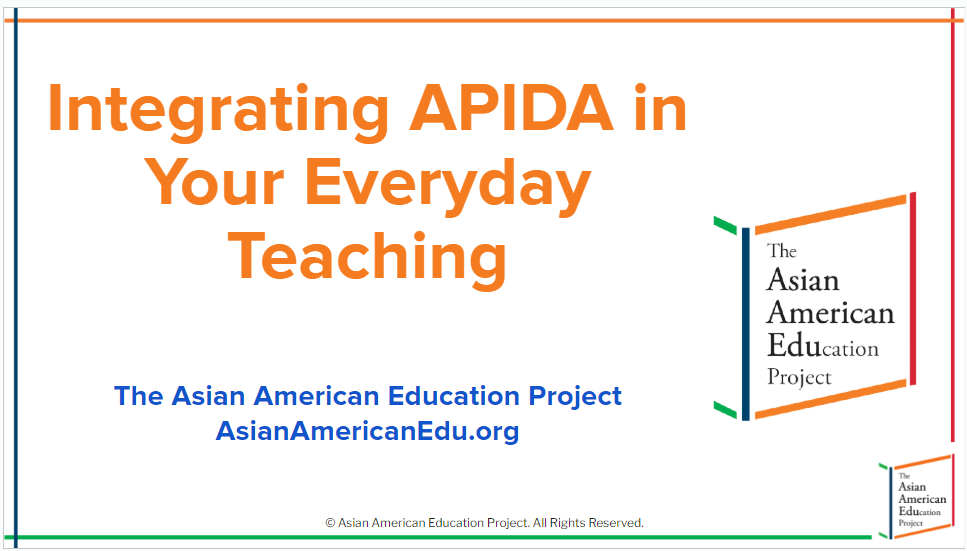 Integrating Asian Pacific Islander Desi Americans (APIDA) in Your Everyday Teaching
Integrating Asian Pacific Islander Desi Americans (APIDA) in Your Everyday Teaching These slides are from a webinar by the Asian American Education Project aimed to help teachers integrate APIDA histories into their existing teaching. The slides share examples of APIDA inclusion into existing curriculum, pedagogical strategies to do so, and reflective questions to help K-12 history teachers probe their own teaching.
Example teaching strategies/historical moments are:
- Angel Island and Ellis Island
- Japanese Incarceration during WWII, Treatment of Muslim Americans and South Asian Americans post 9/11, and U.S. Detention Facilities at the Border
- Tape vs. Hurley and Brown vs. Board
- Immigration Patterns of Southeast Asian refugees as a result of the Vietnam War
- Lue Gim Gong saves Florida's Citrus Plants
- Colonization of Hawai'i
-
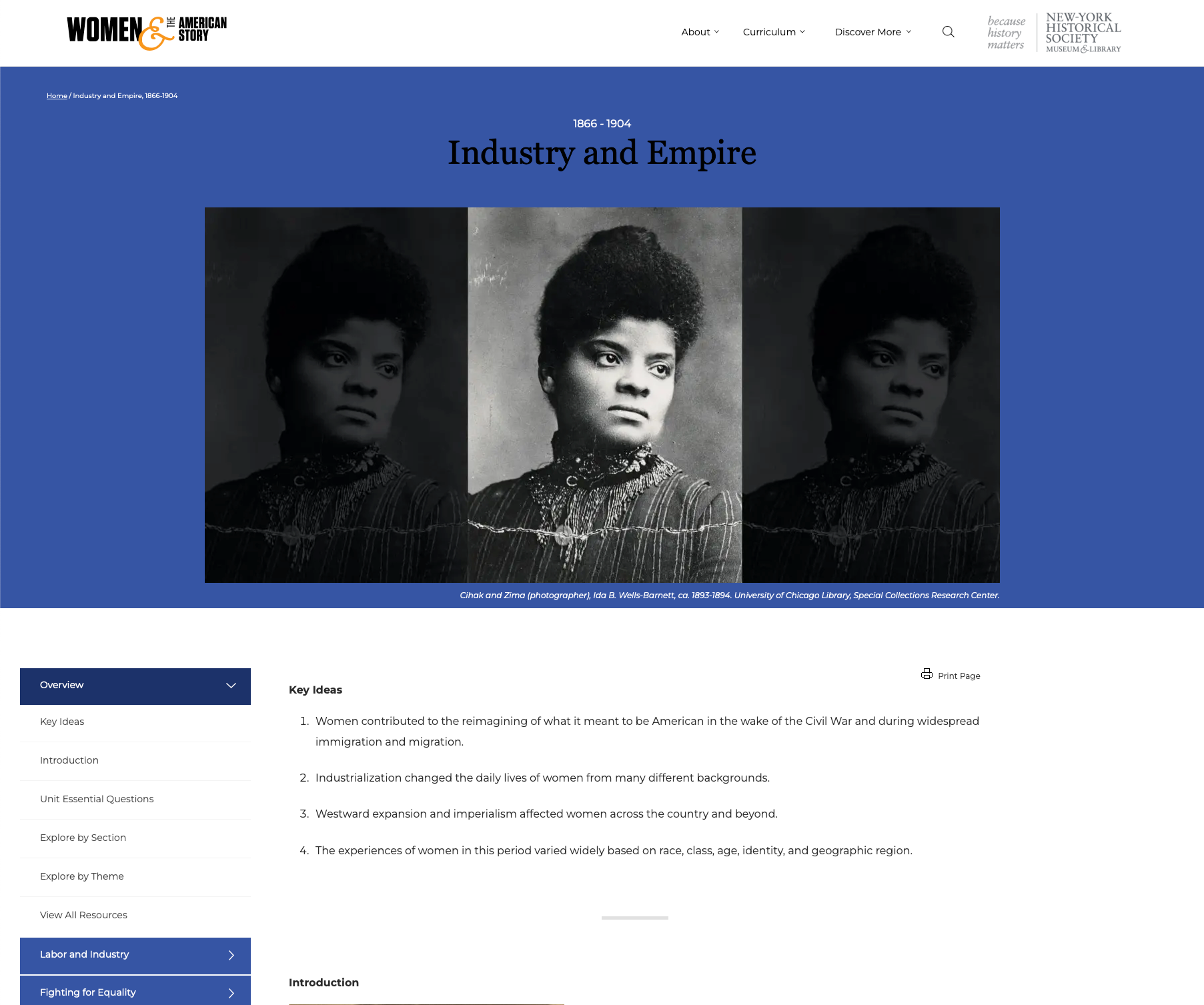 Industry and Empire: Women and the American Story History Unit (1866-1904)
Industry and Empire: Women and the American Story History Unit (1866-1904) Content wise, this unit goes best with 3rd and 4th grade history, 8th grade USHG Eras 5 + 6 and High School USHG Era 6. There are opportunities for geography, economics, and civics integration. Which standards are best will depend on the resources you include, how you include them, and the grade you teach. That said, we do recommend these resources for all grades to help develop historical thinking and inquiry skills described in the K - 12 standards.
-
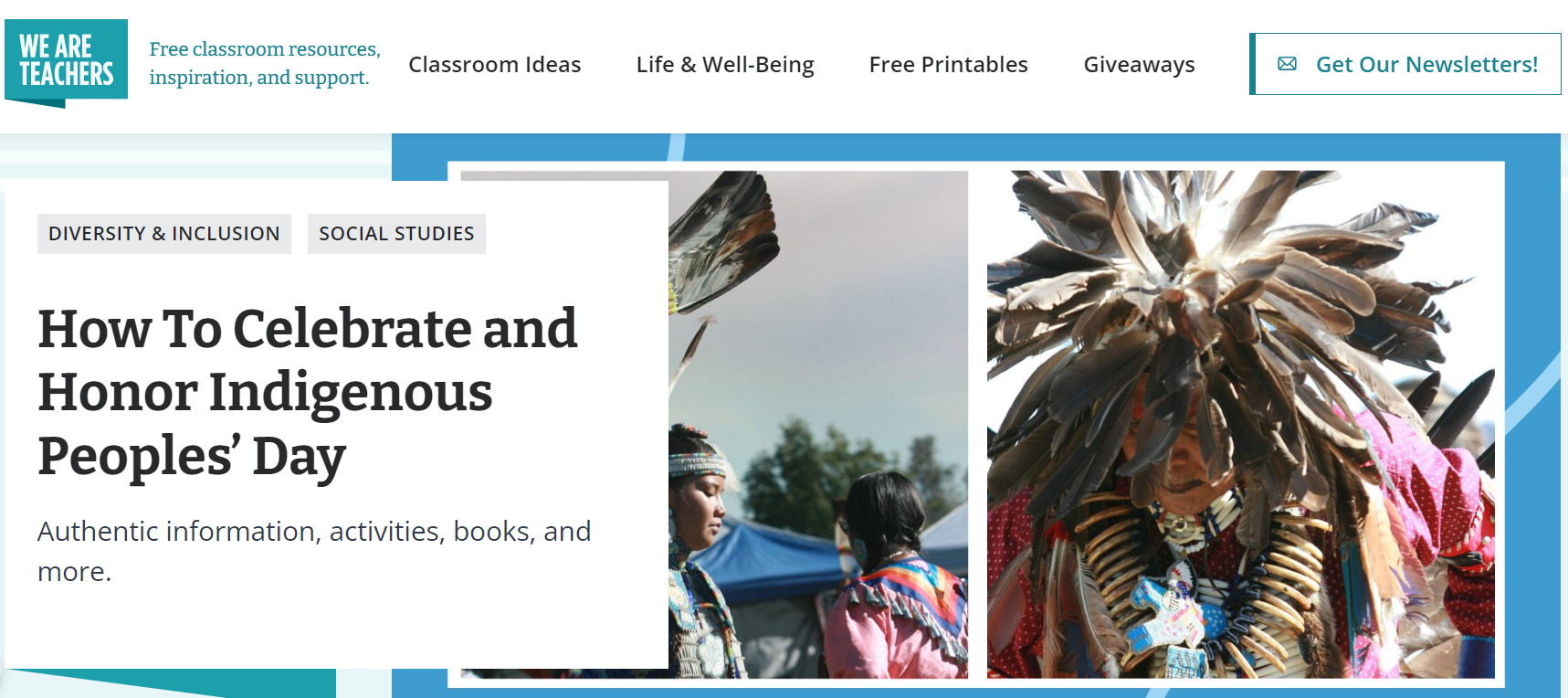 How To Celebrate and Honor Indigenous Peoples’ Day
How To Celebrate and Honor Indigenous Peoples’ Day Paul Flores IV (Apache) details ways to include Indigenous knowledges, histories, and cultures into your teaching, especially if you do not identify as Indigenous.
Flores says in paragraph 3, and we want to highlight: "It’s important to approach topics related to Indigenous peoples with thoughtfulness and care, as many of these subjects can be quite sensitive. Previewing any content before showing your class is recommended to make sure it’s presented in a respectful, culturally appropriate manner. By making the effort to learn directly from Native voices, you can gain invaluable insights into the vibrant, living cultures that have inhabited this land for millennia and participate in the important work of honoring and preserving these irreplaceable traditions."
-
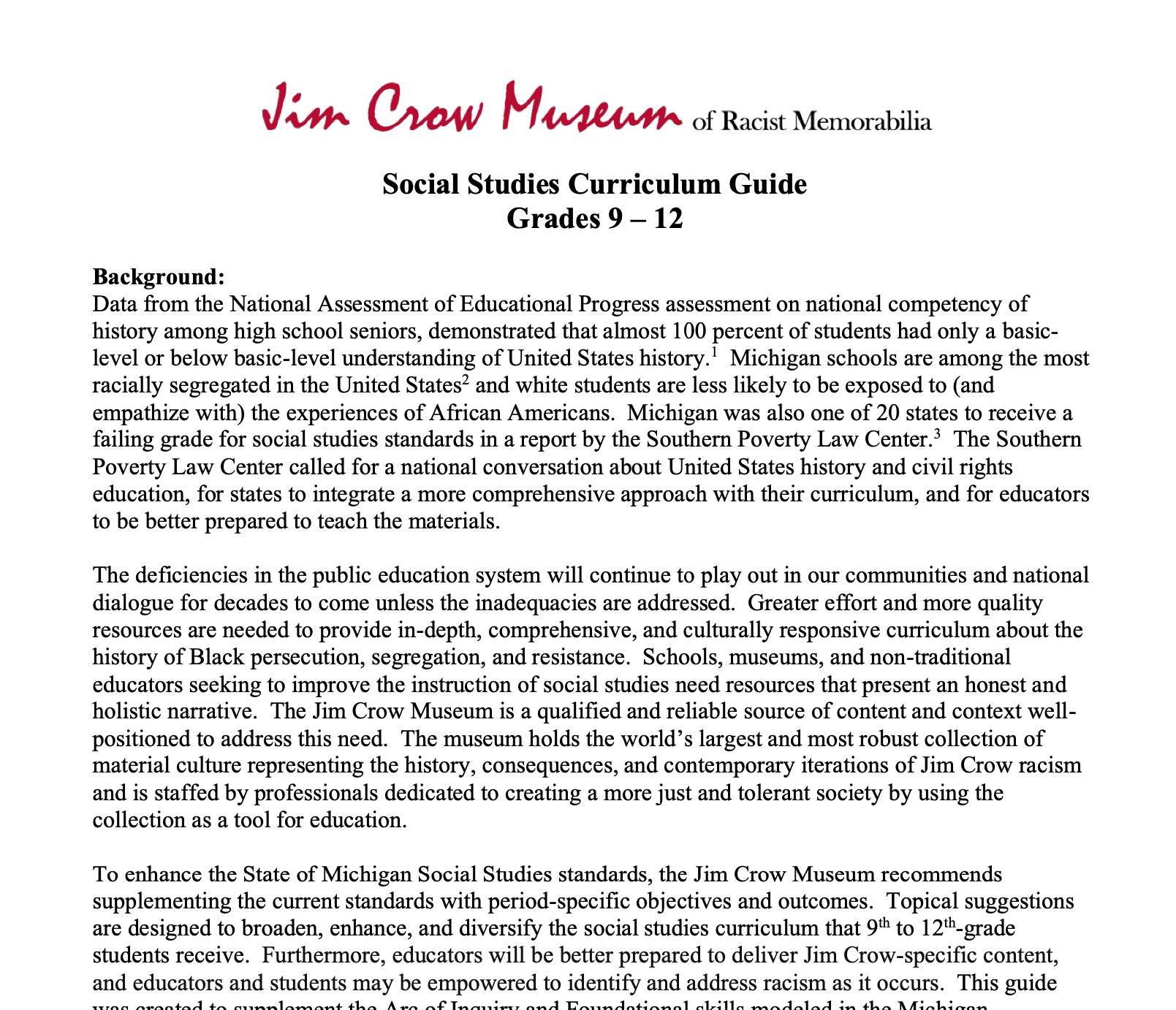 High School Social Studies Curriculum Guide by the Jim Crow Museum of Racist Memorabilia, Ferris State
High School Social Studies Curriculum Guide by the Jim Crow Museum of Racist Memorabilia, Ferris State
-
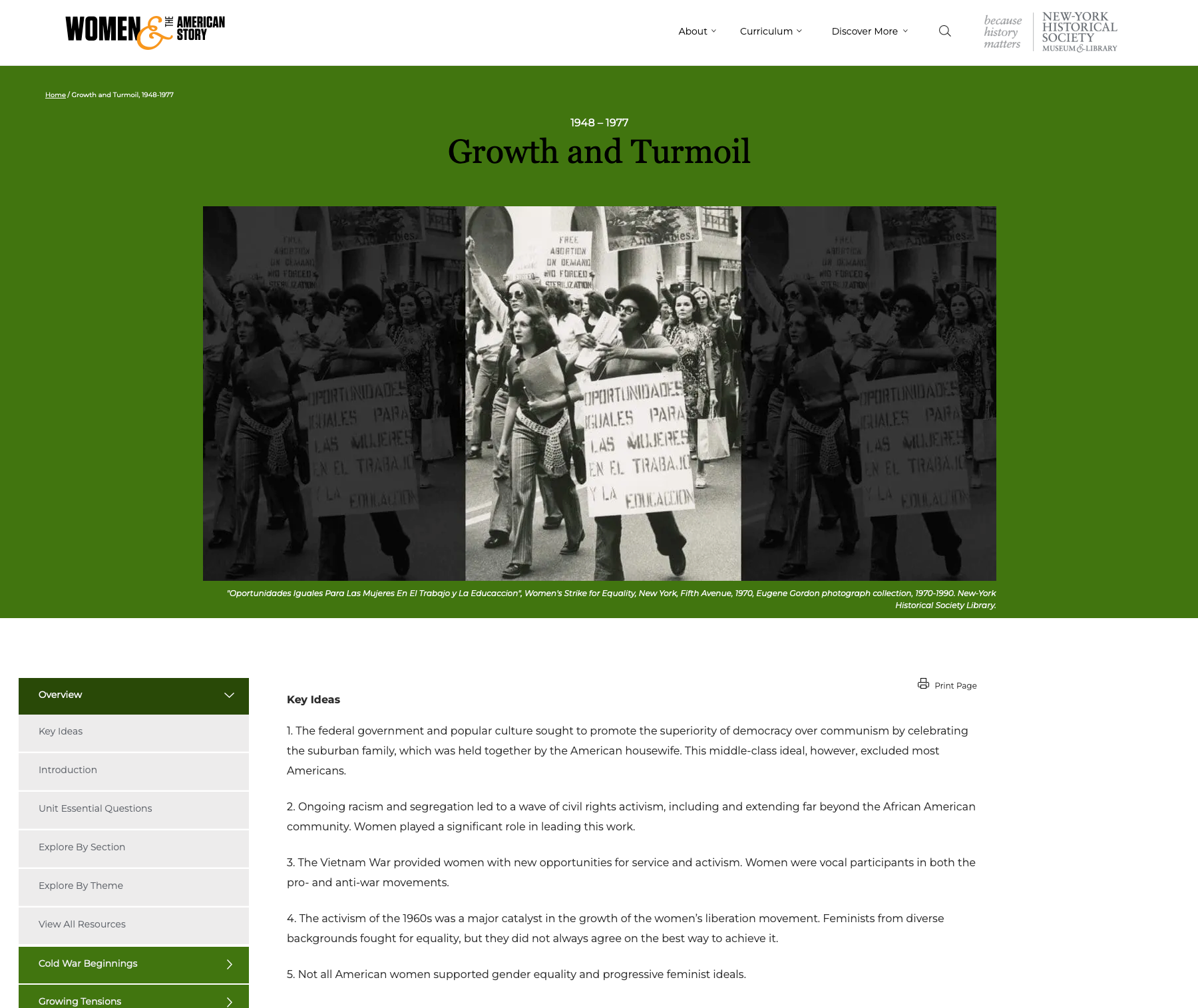 Growth and Turmoil: U.S. History Unit (1948–1977)
Growth and Turmoil: U.S. History Unit (1948–1977) Content wise, this unit goes best with High School USHG Eras 7 + 8. There are opportunities for geography, economics, and civics integration.
-
 Famous Author Study #1: Langston Hughes
Famous Author Study #1: Langston Hughes SOCIAL STUDIES STANDARDS:
7 – H1.2.2 Read and comprehend a historical passage to identify basic factual knowledge and the literal meaning by indicating who was involved, what happened, where it happened, what events led to the development, and what consequences or outcomes followed.
-
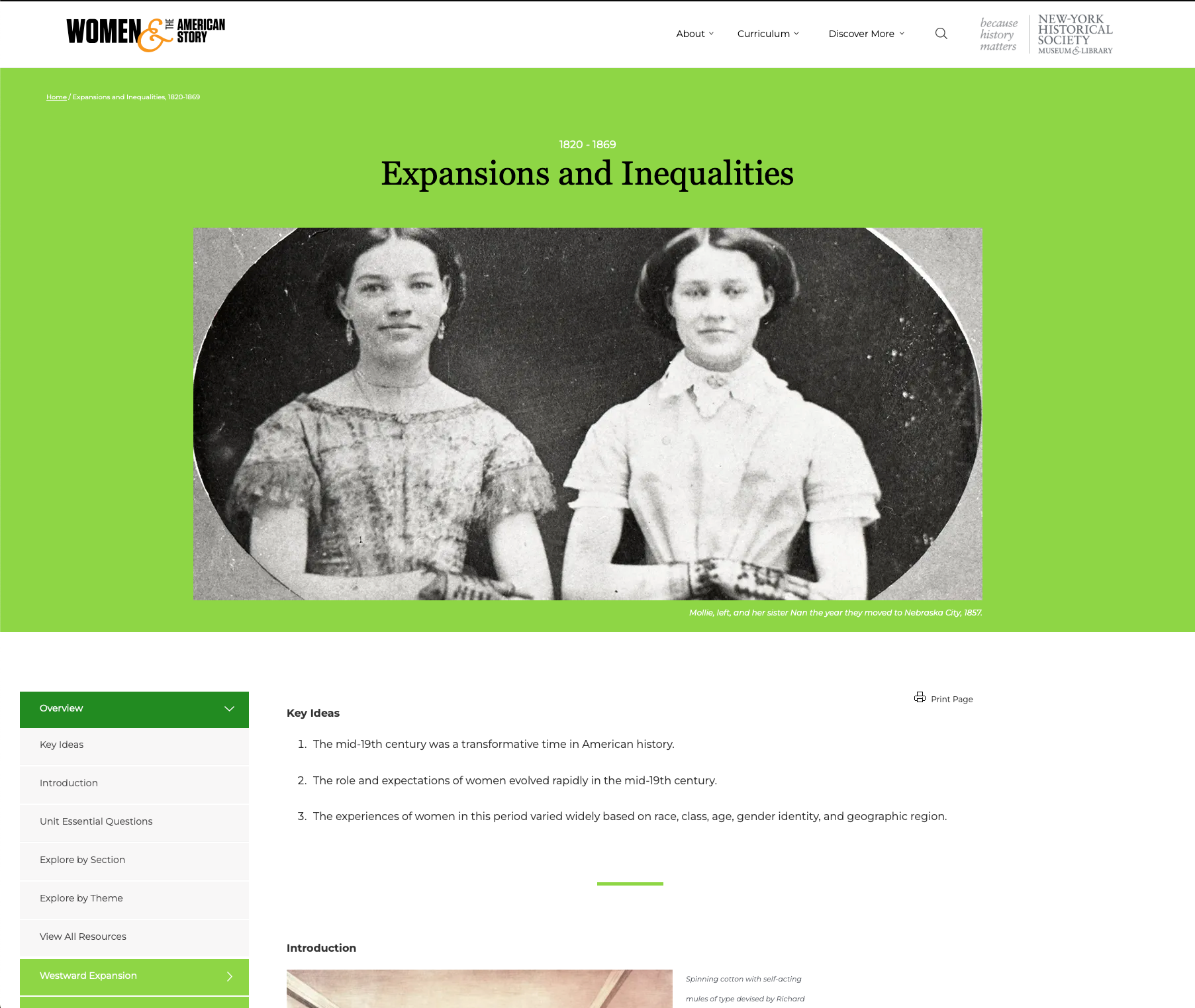 Expansions and Inequalities: Women and the American Story History Unit (1820-1869)
Expansions and Inequalities: Women and the American Story History Unit (1820-1869) Content wise, this unit goes best with 8th grade USHG Eras 4 + 5. There are opportunities for geography, economics, and civics integration. Which standards are best will depend on the resources you include, how you include them, and the grade you teach. That said, we do recommend these resources for all grades to help develop historical thinking and inquiry skills described in the K - 12 standards.
-
 End of the Twentieth Century Women and the American Story History Unit (1977-2001): A Conservative Turn
End of the Twentieth Century Women and the American Story History Unit (1977-2001): A Conservative Turn Content wise, this unit goes best with High School USHG Eras 8+ 9. There are opportunities for geography, economics, and civics integration. Which standards are best will depend on the resources you include, how you include them, and the grade you teach. That said, we do recommend these resources for all grades to help develop historical thinking and inquiry skills described in the K - 12 standards.
-
 Early Encounters: Women and the American Story History Unit (1492-1734)
Early Encounters: Women and the American Story History Unit (1492-1734) Content wise, this unit goes best with 3rd Grade history and 5th grade USHG Eras 1 and 2. Which standards are best will depend on the resources you include, how you include them, and the grade you teach. That said, we do recommend these resources for all grades to help develop historical thinking and inquiry skills described in the K - 12 standards.
-
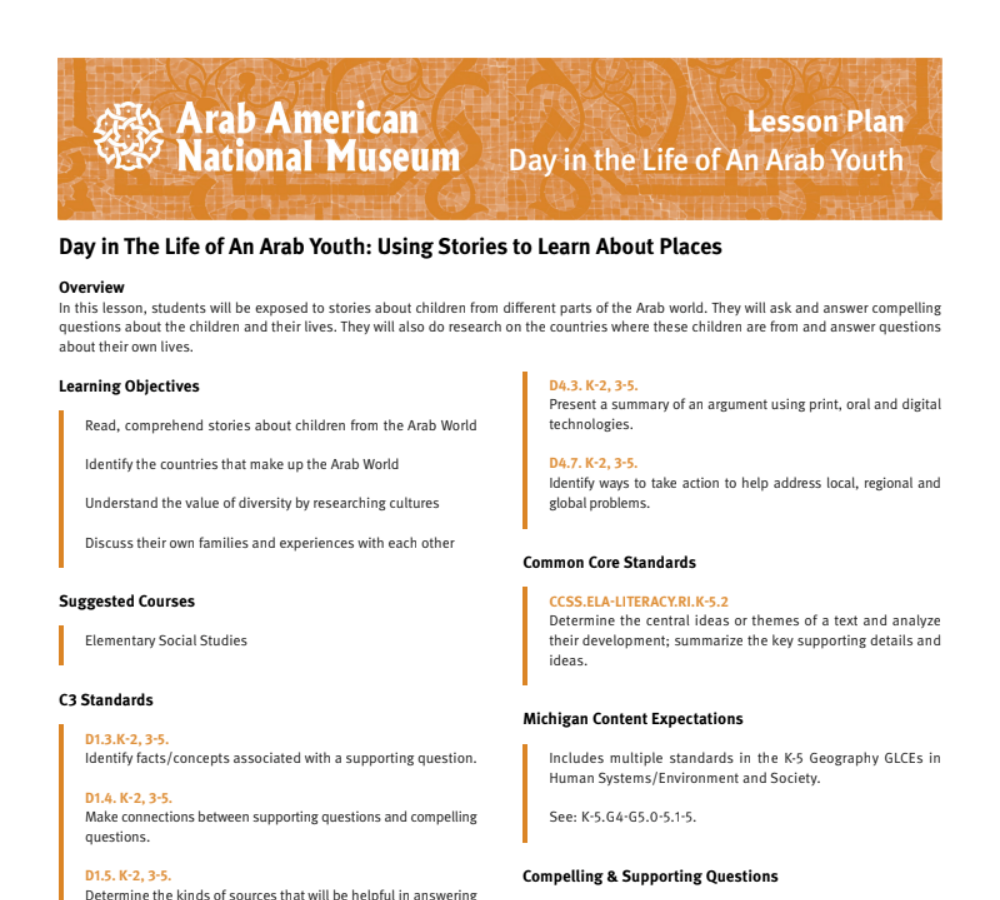 Day in The Life of An Arab Youth: A Lesson Plan Using Stories to Learn About Places
Day in The Life of An Arab Youth: A Lesson Plan Using Stories to Learn About Places SOCIAL STUDIES:
2 – G4.0.3 Use components of culture to describe diversity in the local community.
 Who Killed Vincent Chin: Civil Rights Activism USHG 8.3.4 Civil Rights Expanded – evaluate the major accomplishments and setbacks in securing civil rights and liberties for all Americans over the 20th century.
Who Killed Vincent Chin: Civil Rights Activism USHG 8.3.4 Civil Rights Expanded – evaluate the major accomplishments and setbacks in securing civil rights and liberties for all Americans over the 20th century. Understanding Arab Refugees Unit Plan
Understanding Arab Refugees Unit Plan  Ugly History: The Armenian Genocide WHG 7.2.1 World War I – explain the causes, characteristics, and long-term consequences of World War I, including the major decisions of the Versailles Treaty.
Ugly History: The Armenian Genocide WHG 7.2.1 World War I – explain the causes, characteristics, and long-term consequences of World War I, including the major decisions of the Versailles Treaty. This Land is Our Land Inquiry Unit: "How did (does) Europeans’ view of land impact their (our) relationship and interactions with Indigenous peoples?" SOCIAL STUDIES: 3 – H3.0.5 Use informational text and visual data to compare how Indigenous Peoples and non-Indigenous Peoples in the early history of Michigan interacted with, adapted to, used, and/or modified their environments.
This Land is Our Land Inquiry Unit: "How did (does) Europeans’ view of land impact their (our) relationship and interactions with Indigenous peoples?" SOCIAL STUDIES: 3 – H3.0.5 Use informational text and visual data to compare how Indigenous Peoples and non-Indigenous Peoples in the early history of Michigan interacted with, adapted to, used, and/or modified their environments. The LGBTQ+ Identity: Teacher's Guide From the website: "Understanding LGBTQ+ Identity: A Toolkit for Educators offers a series of digital media resources to help teachers, administrators, guidance counselors, and other educators understand and effectively address the complex and difficult issues faced by LGBTQ students. "These resources, intended for use in teacher professional development settings or with GSAs, feature short segments of video content from the groundbreaking PBS Digital Studios show First Person. First Person delivers candid personal narratives illustrating larger conversations about gender, sexuality, social norms, and identity development. "All video content is scaffolded by a suite of materials (informational text, conversation guides, discussion questions, and teaching tips) to facilitate their use in either classroom or professional development settings. The videos and accompanying educational resources are designed to help promote understanding, awareness, and self-esteem."
The LGBTQ+ Identity: Teacher's Guide From the website: "Understanding LGBTQ+ Identity: A Toolkit for Educators offers a series of digital media resources to help teachers, administrators, guidance counselors, and other educators understand and effectively address the complex and difficult issues faced by LGBTQ students. "These resources, intended for use in teacher professional development settings or with GSAs, feature short segments of video content from the groundbreaking PBS Digital Studios show First Person. First Person delivers candid personal narratives illustrating larger conversations about gender, sexuality, social norms, and identity development. "All video content is scaffolded by a suite of materials (informational text, conversation guides, discussion questions, and teaching tips) to facilitate their use in either classroom or professional development settings. The videos and accompanying educational resources are designed to help promote understanding, awareness, and self-esteem." Teacher’s Guide: Analyzing Primary Sources A one-page guide for teachers on how to support students learning from and about primary sources.
Teacher’s Guide: Analyzing Primary Sources A one-page guide for teachers on how to support students learning from and about primary sources. Settler Colonialism and the American Revolution: Women and the American Story History Unit (1692-1783) Content wise, this unit goes best with 3rd grade history and 5th grade USHG Eras 2 and 3. There are opportunities for geography, economics, and civics integration. Which standards are best will depend on the resources you include, how you include them, and the grade you teach. That said, we do recommend these resources for all grades to help develop historical thinking and inquiry skills described in the K - 12 standards.
Settler Colonialism and the American Revolution: Women and the American Story History Unit (1692-1783) Content wise, this unit goes best with 3rd grade history and 5th grade USHG Eras 2 and 3. There are opportunities for geography, economics, and civics integration. Which standards are best will depend on the resources you include, how you include them, and the grade you teach. That said, we do recommend these resources for all grades to help develop historical thinking and inquiry skills described in the K - 12 standards. Research and Resources on American Muslims and the Impact in the United States of Events in Gaza, Israel, and Surrounding Region
Research and Resources on American Muslims and the Impact in the United States of Events in Gaza, Israel, and Surrounding Region  Muslim students face tough challenges during Ramadan. Here's what teachers can do to help.
Muslim students face tough challenges during Ramadan. Here's what teachers can do to help.  Modernizing America: Women and the American Story History Unit (1889–1920) Content wise, this unit goes best with 8th grade and High School USHG Era 6. There are opportunities for geography, economics, and civics integration. Which standards are best will depend on the resources you include, how you include them, and the grade you teach. That said, we do recommend these resources for all grades to help develop historical thinking and inquiry skills described in the K - 12 standards.
Modernizing America: Women and the American Story History Unit (1889–1920) Content wise, this unit goes best with 8th grade and High School USHG Era 6. There are opportunities for geography, economics, and civics integration. Which standards are best will depend on the resources you include, how you include them, and the grade you teach. That said, we do recommend these resources for all grades to help develop historical thinking and inquiry skills described in the K - 12 standards. Maawndoonganan: Anishinaabe Resource Manual to Accompany the State of Michigan Social Studies Standards K-12 applicable. Content expectation alignment is found within the document.
Maawndoonganan: Anishinaabe Resource Manual to Accompany the State of Michigan Social Studies Standards K-12 applicable. Content expectation alignment is found within the document. Let’s Talk about Race: It isn’t Real, but Racism is Lesson Plan and Materials "Objective: Students will begin the process of “unlearning” the deeply ingrained societal myth that race is a biological reality by tracing the origins of the invention of ‘race.' "THIS KEY CONCEPT IN AN ANTIRACIST CLASSROOM: “Racism is real, Race is not...so race does not account for racism.” - Dr. Barbara Fields "If race isn’t real, where does racism come from? This lesson follows the research of Dr. Barbara Fields and Dr. Ibram X. Kendi to show to students that racism does not actually come from ignorance or hate, but from racist policies which were created for the financial benefit of people in power. Later, racism was invented to justify those racist policies. Unfortunately, the made-up idea of race is going to have a gigantic impact on the story of American history. "
Let’s Talk about Race: It isn’t Real, but Racism is Lesson Plan and Materials "Objective: Students will begin the process of “unlearning” the deeply ingrained societal myth that race is a biological reality by tracing the origins of the invention of ‘race.' "THIS KEY CONCEPT IN AN ANTIRACIST CLASSROOM: “Racism is real, Race is not...so race does not account for racism.” - Dr. Barbara Fields "If race isn’t real, where does racism come from? This lesson follows the research of Dr. Barbara Fields and Dr. Ibram X. Kendi to show to students that racism does not actually come from ignorance or hate, but from racist policies which were created for the financial benefit of people in power. Later, racism was invented to justify those racist policies. Unfortunately, the made-up idea of race is going to have a gigantic impact on the story of American history. " Lawmakers or Lawbreakers? The Crosswhites and Community of Marshall, Michigan 4 – H3.0.3 Use case studies or stories to describe the ideas and actions of individuals involved in the Underground Railroad in Michigan and in the Great Lakes region.
Lawmakers or Lawbreakers? The Crosswhites and Community of Marshall, Michigan 4 – H3.0.3 Use case studies or stories to describe the ideas and actions of individuals involved in the Underground Railroad in Michigan and in the Great Lakes region. It Starts With Me! Lesson Plan K – C5.0.1 Describe situations in which they demonstrated self-discipline and individual responsibility.
It Starts With Me! Lesson Plan K – C5.0.1 Describe situations in which they demonstrated self-discipline and individual responsibility. Integrating Asian Pacific Islander Desi Americans (APIDA) in Your Everyday Teaching These slides are from a webinar by the Asian American Education Project aimed to help teachers integrate APIDA histories into their existing teaching. The slides share examples of APIDA inclusion into existing curriculum, pedagogical strategies to do so, and reflective questions to help K-12 history teachers probe their own teaching. Example teaching strategies/historical moments are: - Angel Island and Ellis Island - Japanese Incarceration during WWII, Treatment of Muslim Americans and South Asian Americans post 9/11, and U.S. Detention Facilities at the Border - Tape vs. Hurley and Brown vs. Board - Immigration Patterns of Southeast Asian refugees as a result of the Vietnam War - Lue Gim Gong saves Florida's Citrus Plants - Colonization of Hawai'i
Integrating Asian Pacific Islander Desi Americans (APIDA) in Your Everyday Teaching These slides are from a webinar by the Asian American Education Project aimed to help teachers integrate APIDA histories into their existing teaching. The slides share examples of APIDA inclusion into existing curriculum, pedagogical strategies to do so, and reflective questions to help K-12 history teachers probe their own teaching. Example teaching strategies/historical moments are: - Angel Island and Ellis Island - Japanese Incarceration during WWII, Treatment of Muslim Americans and South Asian Americans post 9/11, and U.S. Detention Facilities at the Border - Tape vs. Hurley and Brown vs. Board - Immigration Patterns of Southeast Asian refugees as a result of the Vietnam War - Lue Gim Gong saves Florida's Citrus Plants - Colonization of Hawai'i Industry and Empire: Women and the American Story History Unit (1866-1904) Content wise, this unit goes best with 3rd and 4th grade history, 8th grade USHG Eras 5 + 6 and High School USHG Era 6. There are opportunities for geography, economics, and civics integration. Which standards are best will depend on the resources you include, how you include them, and the grade you teach. That said, we do recommend these resources for all grades to help develop historical thinking and inquiry skills described in the K - 12 standards.
Industry and Empire: Women and the American Story History Unit (1866-1904) Content wise, this unit goes best with 3rd and 4th grade history, 8th grade USHG Eras 5 + 6 and High School USHG Era 6. There are opportunities for geography, economics, and civics integration. Which standards are best will depend on the resources you include, how you include them, and the grade you teach. That said, we do recommend these resources for all grades to help develop historical thinking and inquiry skills described in the K - 12 standards. How To Celebrate and Honor Indigenous Peoples’ Day Paul Flores IV (Apache) details ways to include Indigenous knowledges, histories, and cultures into your teaching, especially if you do not identify as Indigenous. Flores says in paragraph 3, and we want to highlight: "It’s important to approach topics related to Indigenous peoples with thoughtfulness and care, as many of these subjects can be quite sensitive. Previewing any content before showing your class is recommended to make sure it’s presented in a respectful, culturally appropriate manner. By making the effort to learn directly from Native voices, you can gain invaluable insights into the vibrant, living cultures that have inhabited this land for millennia and participate in the important work of honoring and preserving these irreplaceable traditions."
How To Celebrate and Honor Indigenous Peoples’ Day Paul Flores IV (Apache) details ways to include Indigenous knowledges, histories, and cultures into your teaching, especially if you do not identify as Indigenous. Flores says in paragraph 3, and we want to highlight: "It’s important to approach topics related to Indigenous peoples with thoughtfulness and care, as many of these subjects can be quite sensitive. Previewing any content before showing your class is recommended to make sure it’s presented in a respectful, culturally appropriate manner. By making the effort to learn directly from Native voices, you can gain invaluable insights into the vibrant, living cultures that have inhabited this land for millennia and participate in the important work of honoring and preserving these irreplaceable traditions." High School Social Studies Curriculum Guide by the Jim Crow Museum of Racist Memorabilia, Ferris State
High School Social Studies Curriculum Guide by the Jim Crow Museum of Racist Memorabilia, Ferris State  Growth and Turmoil: U.S. History Unit (1948–1977) Content wise, this unit goes best with High School USHG Eras 7 + 8. There are opportunities for geography, economics, and civics integration.
Growth and Turmoil: U.S. History Unit (1948–1977) Content wise, this unit goes best with High School USHG Eras 7 + 8. There are opportunities for geography, economics, and civics integration. Famous Author Study #1: Langston Hughes SOCIAL STUDIES STANDARDS: 7 – H1.2.2 Read and comprehend a historical passage to identify basic factual knowledge and the literal meaning by indicating who was involved, what happened, where it happened, what events led to the development, and what consequences or outcomes followed.
Famous Author Study #1: Langston Hughes SOCIAL STUDIES STANDARDS: 7 – H1.2.2 Read and comprehend a historical passage to identify basic factual knowledge and the literal meaning by indicating who was involved, what happened, where it happened, what events led to the development, and what consequences or outcomes followed. Expansions and Inequalities: Women and the American Story History Unit (1820-1869) Content wise, this unit goes best with 8th grade USHG Eras 4 + 5. There are opportunities for geography, economics, and civics integration. Which standards are best will depend on the resources you include, how you include them, and the grade you teach. That said, we do recommend these resources for all grades to help develop historical thinking and inquiry skills described in the K - 12 standards.
Expansions and Inequalities: Women and the American Story History Unit (1820-1869) Content wise, this unit goes best with 8th grade USHG Eras 4 + 5. There are opportunities for geography, economics, and civics integration. Which standards are best will depend on the resources you include, how you include them, and the grade you teach. That said, we do recommend these resources for all grades to help develop historical thinking and inquiry skills described in the K - 12 standards. End of the Twentieth Century Women and the American Story History Unit (1977-2001): A Conservative Turn Content wise, this unit goes best with High School USHG Eras 8+ 9. There are opportunities for geography, economics, and civics integration. Which standards are best will depend on the resources you include, how you include them, and the grade you teach. That said, we do recommend these resources for all grades to help develop historical thinking and inquiry skills described in the K - 12 standards.
End of the Twentieth Century Women and the American Story History Unit (1977-2001): A Conservative Turn Content wise, this unit goes best with High School USHG Eras 8+ 9. There are opportunities for geography, economics, and civics integration. Which standards are best will depend on the resources you include, how you include them, and the grade you teach. That said, we do recommend these resources for all grades to help develop historical thinking and inquiry skills described in the K - 12 standards. Early Encounters: Women and the American Story History Unit (1492-1734) Content wise, this unit goes best with 3rd Grade history and 5th grade USHG Eras 1 and 2. Which standards are best will depend on the resources you include, how you include them, and the grade you teach. That said, we do recommend these resources for all grades to help develop historical thinking and inquiry skills described in the K - 12 standards.
Early Encounters: Women and the American Story History Unit (1492-1734) Content wise, this unit goes best with 3rd Grade history and 5th grade USHG Eras 1 and 2. Which standards are best will depend on the resources you include, how you include them, and the grade you teach. That said, we do recommend these resources for all grades to help develop historical thinking and inquiry skills described in the K - 12 standards. Day in The Life of An Arab Youth: A Lesson Plan Using Stories to Learn About Places SOCIAL STUDIES: 2 – G4.0.3 Use components of culture to describe diversity in the local community.
Day in The Life of An Arab Youth: A Lesson Plan Using Stories to Learn About Places SOCIAL STUDIES: 2 – G4.0.3 Use components of culture to describe diversity in the local community.